MITS - Wireless Communication Networks: A Comparative Research Study
VerifiedAdded on 2023/03/20
|10
|2266
|100
Report
AI Summary
This report presents a research study on wireless communication networks, focusing on Orthogonal Frequency Division Multiplexing (OFDM) within optical wireless communication (OWC). It analyzes two research papers: the first examines the performance of OFDM using light-emitting diodes (LEDs), comparing DC-biased and asymmetrically clipped OFDM (DCO-OFDM and ACO-OFDM), and the second proposes Multi-class channel coded layered asymmetrically clipped optical orthogonal frequency-division multiplexing (LACO-OFDM) for enhanced data rates. The report details the methodologies employed in each paper, compares their results, discusses the advantages and disadvantages of each approach, and concludes with potential future directions for improving the performance of optical wireless communication systems. References to the original research papers are included.
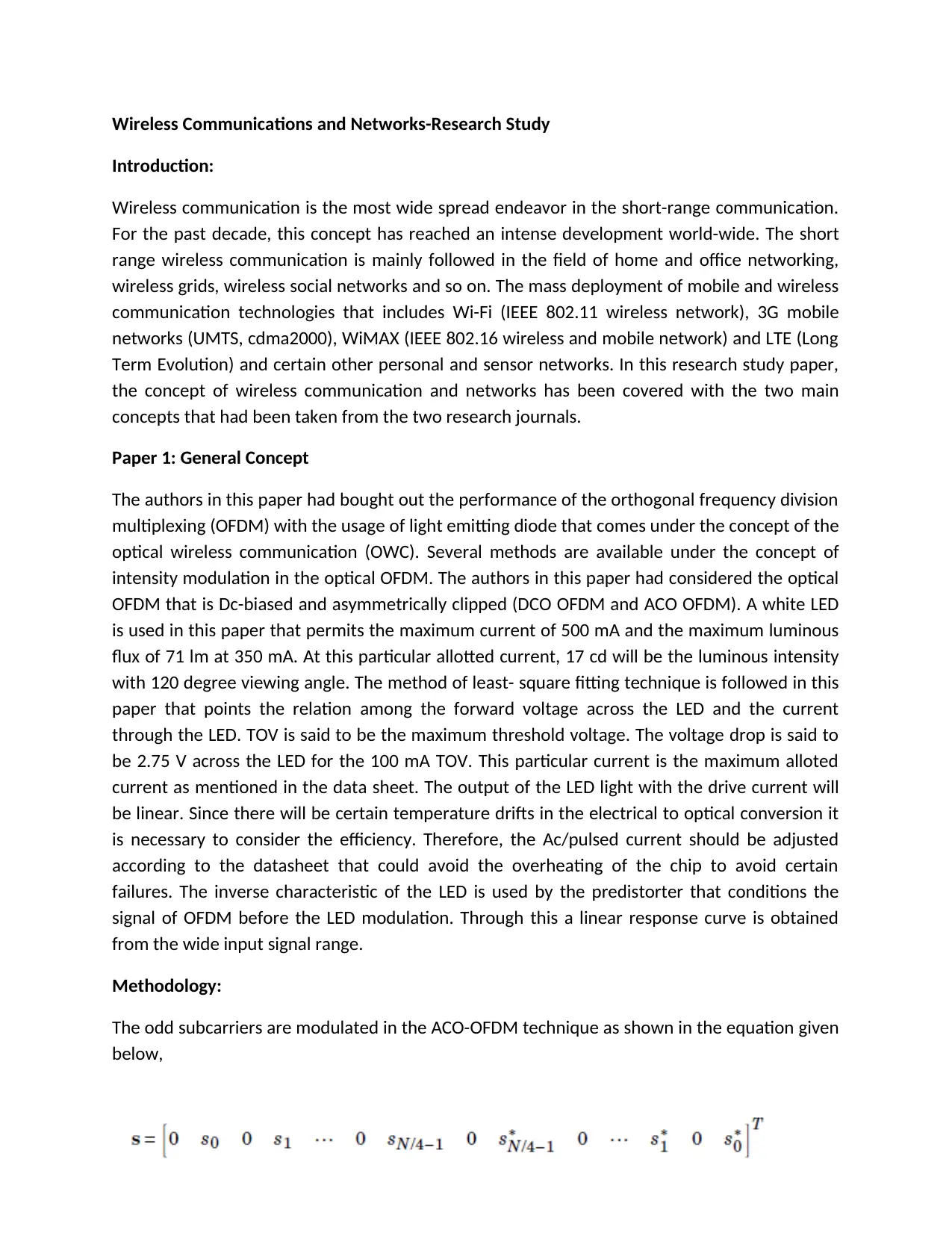
Wireless Communications and Networks-Research Study
Introduction:
Wireless communication is the most wide spread endeavor in the short-range communication.
For the past decade, this concept has reached an intense development world-wide. The short
range wireless communication is mainly followed in the field of home and office networking,
wireless grids, wireless social networks and so on. The mass deployment of mobile and wireless
communication technologies that includes Wi-Fi (IEEE 802.11 wireless network), 3G mobile
networks (UMTS, cdma2000), WiMAX (IEEE 802.16 wireless and mobile network) and LTE (Long
Term Evolution) and certain other personal and sensor networks. In this research study paper,
the concept of wireless communication and networks has been covered with the two main
concepts that had been taken from the two research journals.
Paper 1: General Concept
The authors in this paper had bought out the performance of the orthogonal frequency division
multiplexing (OFDM) with the usage of light emitting diode that comes under the concept of the
optical wireless communication (OWC). Several methods are available under the concept of
intensity modulation in the optical OFDM. The authors in this paper had considered the optical
OFDM that is Dc-biased and asymmetrically clipped (DCO OFDM and ACO OFDM). A white LED
is used in this paper that permits the maximum current of 500 mA and the maximum luminous
flux of 71 lm at 350 mA. At this particular allotted current, 17 cd will be the luminous intensity
with 120 degree viewing angle. The method of least- square fitting technique is followed in this
paper that points the relation among the forward voltage across the LED and the current
through the LED. TOV is said to be the maximum threshold voltage. The voltage drop is said to
be 2.75 V across the LED for the 100 mA TOV. This particular current is the maximum alloted
current as mentioned in the data sheet. The output of the LED light with the drive current will
be linear. Since there will be certain temperature drifts in the electrical to optical conversion it
is necessary to consider the efficiency. Therefore, the Ac/pulsed current should be adjusted
according to the datasheet that could avoid the overheating of the chip to avoid certain
failures. The inverse characteristic of the LED is used by the predistorter that conditions the
signal of OFDM before the LED modulation. Through this a linear response curve is obtained
from the wide input signal range.
Methodology:
The odd subcarriers are modulated in the ACO-OFDM technique as shown in the equation given
below,
Introduction:
Wireless communication is the most wide spread endeavor in the short-range communication.
For the past decade, this concept has reached an intense development world-wide. The short
range wireless communication is mainly followed in the field of home and office networking,
wireless grids, wireless social networks and so on. The mass deployment of mobile and wireless
communication technologies that includes Wi-Fi (IEEE 802.11 wireless network), 3G mobile
networks (UMTS, cdma2000), WiMAX (IEEE 802.16 wireless and mobile network) and LTE (Long
Term Evolution) and certain other personal and sensor networks. In this research study paper,
the concept of wireless communication and networks has been covered with the two main
concepts that had been taken from the two research journals.
Paper 1: General Concept
The authors in this paper had bought out the performance of the orthogonal frequency division
multiplexing (OFDM) with the usage of light emitting diode that comes under the concept of the
optical wireless communication (OWC). Several methods are available under the concept of
intensity modulation in the optical OFDM. The authors in this paper had considered the optical
OFDM that is Dc-biased and asymmetrically clipped (DCO OFDM and ACO OFDM). A white LED
is used in this paper that permits the maximum current of 500 mA and the maximum luminous
flux of 71 lm at 350 mA. At this particular allotted current, 17 cd will be the luminous intensity
with 120 degree viewing angle. The method of least- square fitting technique is followed in this
paper that points the relation among the forward voltage across the LED and the current
through the LED. TOV is said to be the maximum threshold voltage. The voltage drop is said to
be 2.75 V across the LED for the 100 mA TOV. This particular current is the maximum alloted
current as mentioned in the data sheet. The output of the LED light with the drive current will
be linear. Since there will be certain temperature drifts in the electrical to optical conversion it
is necessary to consider the efficiency. Therefore, the Ac/pulsed current should be adjusted
according to the datasheet that could avoid the overheating of the chip to avoid certain
failures. The inverse characteristic of the LED is used by the predistorter that conditions the
signal of OFDM before the LED modulation. Through this a linear response curve is obtained
from the wide input signal range.
Methodology:
The odd subcarriers are modulated in the ACO-OFDM technique as shown in the equation given
below,
Paraphrase This Document
Need a fresh take? Get an instant paraphrase of this document with our AI Paraphraser
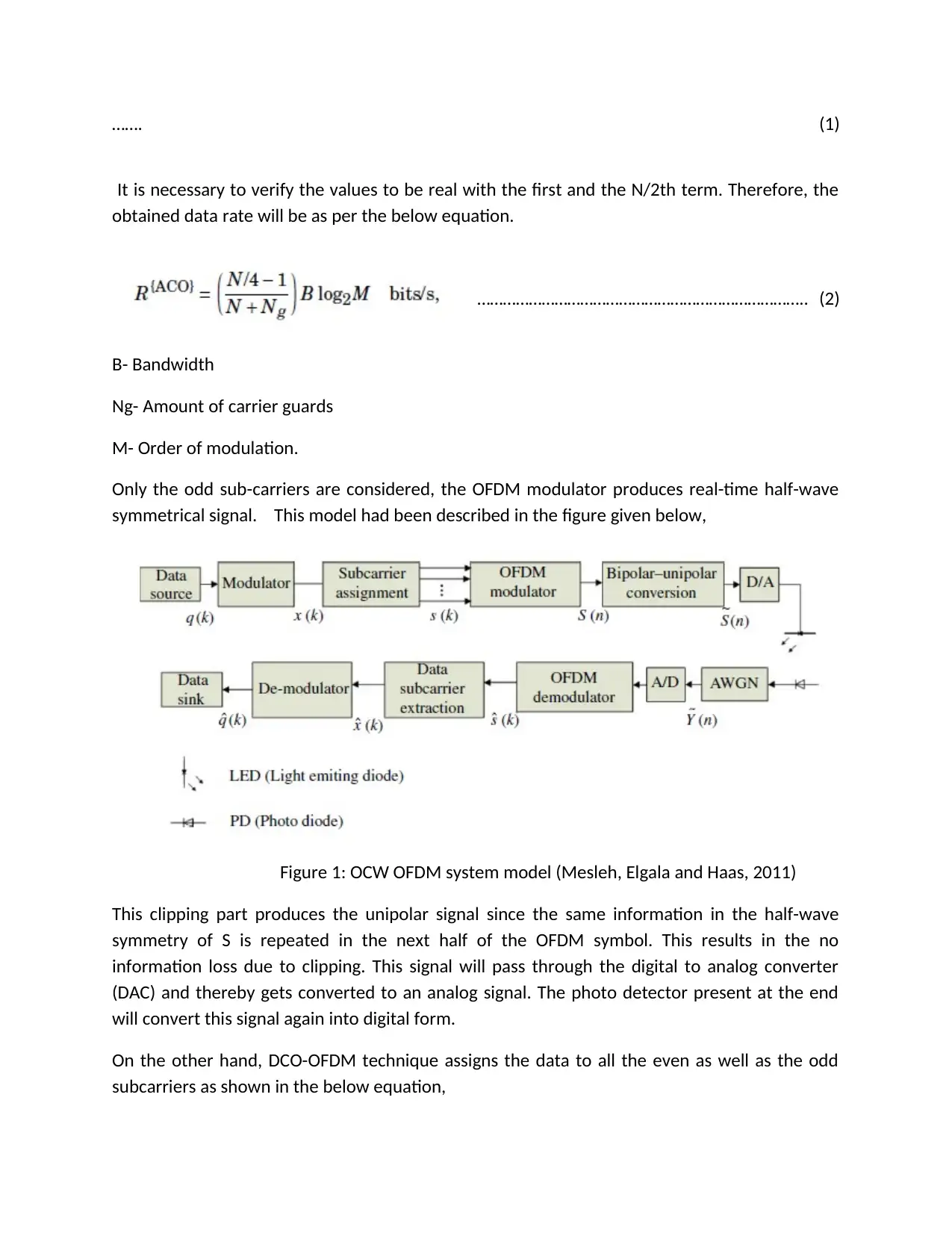
……. (1)
It is necessary to verify the values to be real with the first and the N/2th term. Therefore, the
obtained data rate will be as per the below equation.
………………………………………………………………….. (2)
B- Bandwidth
Ng- Amount of carrier guards
M- Order of modulation.
Only the odd sub-carriers are considered, the OFDM modulator produces real-time half-wave
symmetrical signal. This model had been described in the figure given below,
Figure 1: OCW OFDM system model (Mesleh, Elgala and Haas, 2011)
This clipping part produces the unipolar signal since the same information in the half-wave
symmetry of S is repeated in the next half of the OFDM symbol. This results in the no
information loss due to clipping. This signal will pass through the digital to analog converter
(DAC) and thereby gets converted to an analog signal. The photo detector present at the end
will convert this signal again into digital form.
On the other hand, DCO-OFDM technique assigns the data to all the even as well as the odd
subcarriers as shown in the below equation,
It is necessary to verify the values to be real with the first and the N/2th term. Therefore, the
obtained data rate will be as per the below equation.
………………………………………………………………….. (2)
B- Bandwidth
Ng- Amount of carrier guards
M- Order of modulation.
Only the odd sub-carriers are considered, the OFDM modulator produces real-time half-wave
symmetrical signal. This model had been described in the figure given below,
Figure 1: OCW OFDM system model (Mesleh, Elgala and Haas, 2011)
This clipping part produces the unipolar signal since the same information in the half-wave
symmetry of S is repeated in the next half of the OFDM symbol. This results in the no
information loss due to clipping. This signal will pass through the digital to analog converter
(DAC) and thereby gets converted to an analog signal. The photo detector present at the end
will convert this signal again into digital form.
On the other hand, DCO-OFDM technique assigns the data to all the even as well as the odd
subcarriers as shown in the below equation,
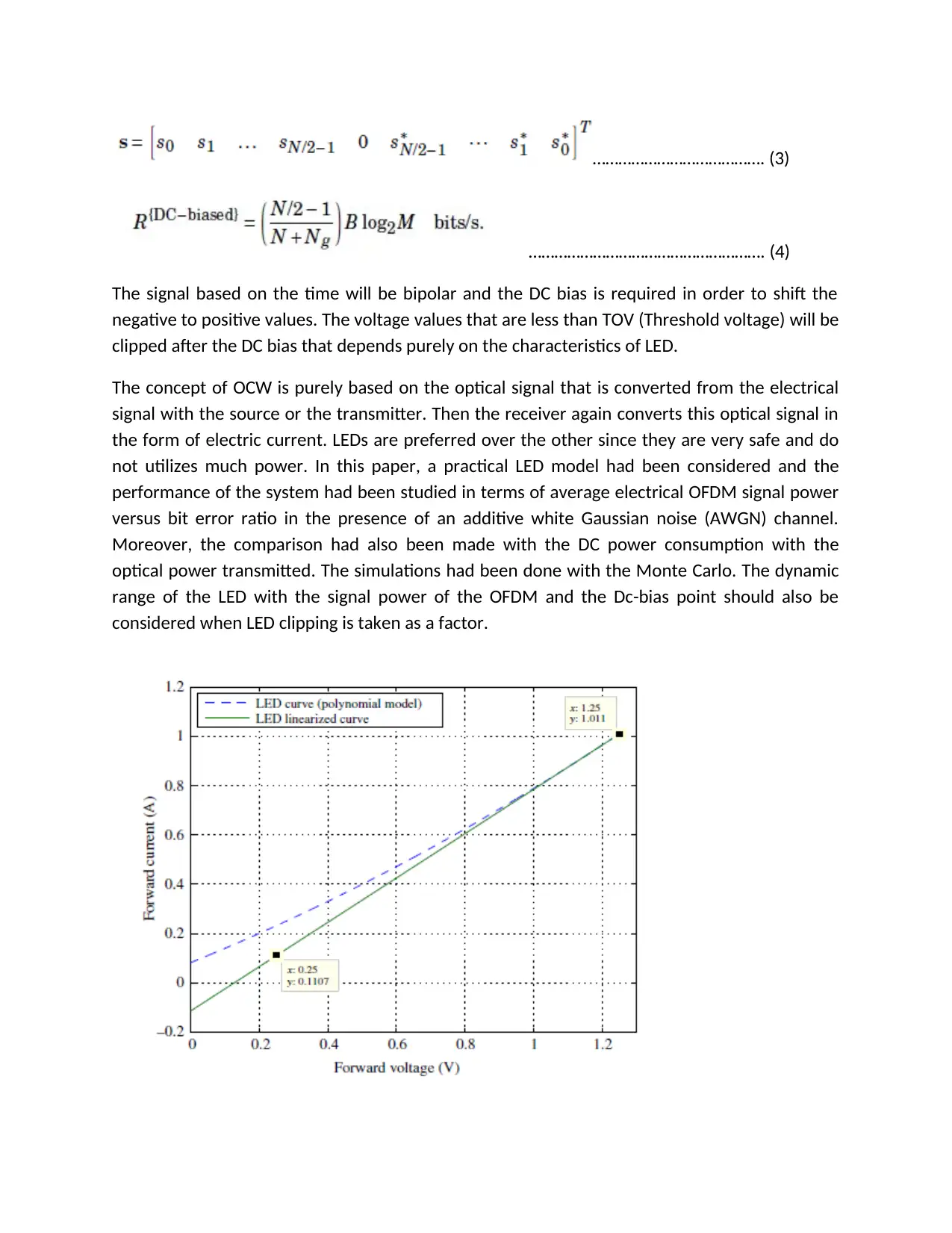
…………………………………. (3)
………………………………………………. (4)
The signal based on the time will be bipolar and the DC bias is required in order to shift the
negative to positive values. The voltage values that are less than TOV (Threshold voltage) will be
clipped after the DC bias that depends purely on the characteristics of LED.
The concept of OCW is purely based on the optical signal that is converted from the electrical
signal with the source or the transmitter. Then the receiver again converts this optical signal in
the form of electric current. LEDs are preferred over the other since they are very safe and do
not utilizes much power. In this paper, a practical LED model had been considered and the
performance of the system had been studied in terms of average electrical OFDM signal power
versus bit error ratio in the presence of an additive white Gaussian noise (AWGN) channel.
Moreover, the comparison had also been made with the DC power consumption with the
optical power transmitted. The simulations had been done with the Monte Carlo. The dynamic
range of the LED with the signal power of the OFDM and the Dc-bias point should also be
considered when LED clipping is taken as a factor.
………………………………………………. (4)
The signal based on the time will be bipolar and the DC bias is required in order to shift the
negative to positive values. The voltage values that are less than TOV (Threshold voltage) will be
clipped after the DC bias that depends purely on the characteristics of LED.
The concept of OCW is purely based on the optical signal that is converted from the electrical
signal with the source or the transmitter. Then the receiver again converts this optical signal in
the form of electric current. LEDs are preferred over the other since they are very safe and do
not utilizes much power. In this paper, a practical LED model had been considered and the
performance of the system had been studied in terms of average electrical OFDM signal power
versus bit error ratio in the presence of an additive white Gaussian noise (AWGN) channel.
Moreover, the comparison had also been made with the DC power consumption with the
optical power transmitted. The simulations had been done with the Monte Carlo. The dynamic
range of the LED with the signal power of the OFDM and the Dc-bias point should also be
considered when LED clipping is taken as a factor.
⊘ This is a preview!⊘
Do you want full access?
Subscribe today to unlock all pages.

Trusted by 1+ million students worldwide
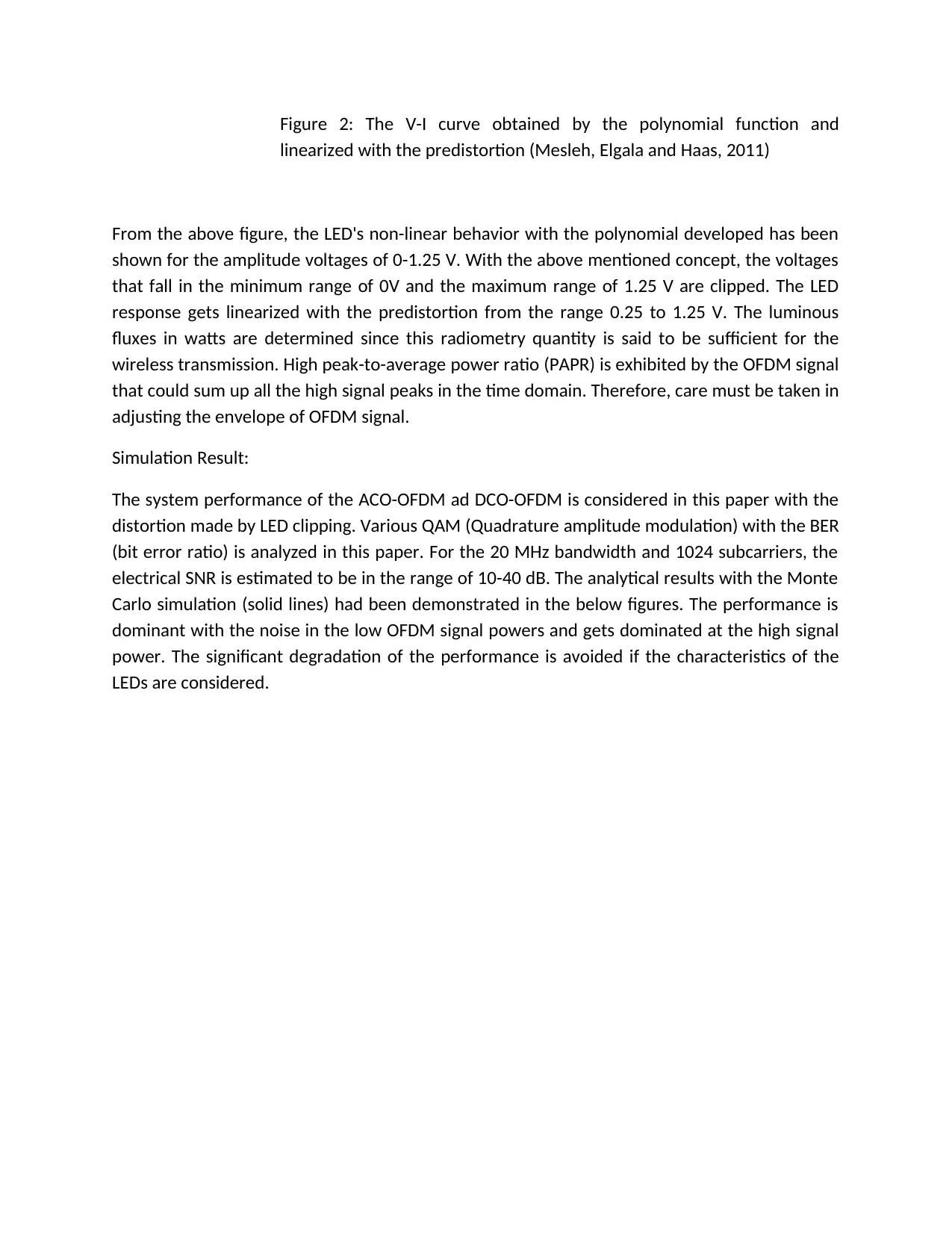
Figure 2: The V-I curve obtained by the polynomial function and
linearized with the predistortion (Mesleh, Elgala and Haas, 2011)
From the above figure, the LED's non-linear behavior with the polynomial developed has been
shown for the amplitude voltages of 0-1.25 V. With the above mentioned concept, the voltages
that fall in the minimum range of 0V and the maximum range of 1.25 V are clipped. The LED
response gets linearized with the predistortion from the range 0.25 to 1.25 V. The luminous
fluxes in watts are determined since this radiometry quantity is said to be sufficient for the
wireless transmission. High peak-to-average power ratio (PAPR) is exhibited by the OFDM signal
that could sum up all the high signal peaks in the time domain. Therefore, care must be taken in
adjusting the envelope of OFDM signal.
Simulation Result:
The system performance of the ACO-OFDM ad DCO-OFDM is considered in this paper with the
distortion made by LED clipping. Various QAM (Quadrature amplitude modulation) with the BER
(bit error ratio) is analyzed in this paper. For the 20 MHz bandwidth and 1024 subcarriers, the
electrical SNR is estimated to be in the range of 10-40 dB. The analytical results with the Monte
Carlo simulation (solid lines) had been demonstrated in the below figures. The performance is
dominant with the noise in the low OFDM signal powers and gets dominated at the high signal
power. The significant degradation of the performance is avoided if the characteristics of the
LEDs are considered.
linearized with the predistortion (Mesleh, Elgala and Haas, 2011)
From the above figure, the LED's non-linear behavior with the polynomial developed has been
shown for the amplitude voltages of 0-1.25 V. With the above mentioned concept, the voltages
that fall in the minimum range of 0V and the maximum range of 1.25 V are clipped. The LED
response gets linearized with the predistortion from the range 0.25 to 1.25 V. The luminous
fluxes in watts are determined since this radiometry quantity is said to be sufficient for the
wireless transmission. High peak-to-average power ratio (PAPR) is exhibited by the OFDM signal
that could sum up all the high signal peaks in the time domain. Therefore, care must be taken in
adjusting the envelope of OFDM signal.
Simulation Result:
The system performance of the ACO-OFDM ad DCO-OFDM is considered in this paper with the
distortion made by LED clipping. Various QAM (Quadrature amplitude modulation) with the BER
(bit error ratio) is analyzed in this paper. For the 20 MHz bandwidth and 1024 subcarriers, the
electrical SNR is estimated to be in the range of 10-40 dB. The analytical results with the Monte
Carlo simulation (solid lines) had been demonstrated in the below figures. The performance is
dominant with the noise in the low OFDM signal powers and gets dominated at the high signal
power. The significant degradation of the performance is avoided if the characteristics of the
LEDs are considered.
Paraphrase This Document
Need a fresh take? Get an instant paraphrase of this document with our AI Paraphraser
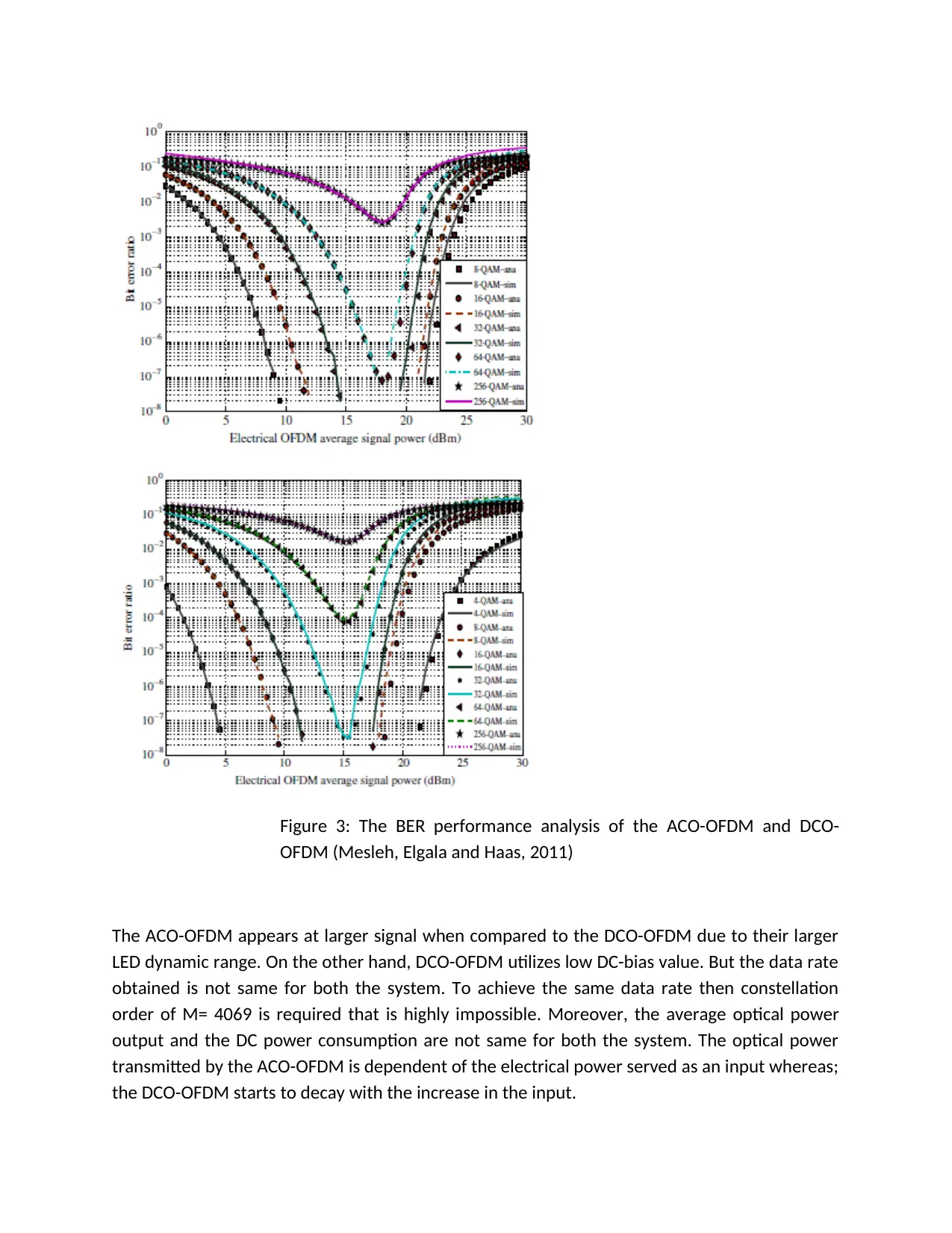
Figure 3: The BER performance analysis of the ACO-OFDM and DCO-
OFDM (Mesleh, Elgala and Haas, 2011)
The ACO-OFDM appears at larger signal when compared to the DCO-OFDM due to their larger
LED dynamic range. On the other hand, DCO-OFDM utilizes low DC-bias value. But the data rate
obtained is not same for both the system. To achieve the same data rate then constellation
order of M= 4069 is required that is highly impossible. Moreover, the average optical power
output and the DC power consumption are not same for both the system. The optical power
transmitted by the ACO-OFDM is dependent of the electrical power served as an input whereas;
the DCO-OFDM starts to decay with the increase in the input.
OFDM (Mesleh, Elgala and Haas, 2011)
The ACO-OFDM appears at larger signal when compared to the DCO-OFDM due to their larger
LED dynamic range. On the other hand, DCO-OFDM utilizes low DC-bias value. But the data rate
obtained is not same for both the system. To achieve the same data rate then constellation
order of M= 4069 is required that is highly impossible. Moreover, the average optical power
output and the DC power consumption are not same for both the system. The optical power
transmitted by the ACO-OFDM is dependent of the electrical power served as an input whereas;
the DCO-OFDM starts to decay with the increase in the input.
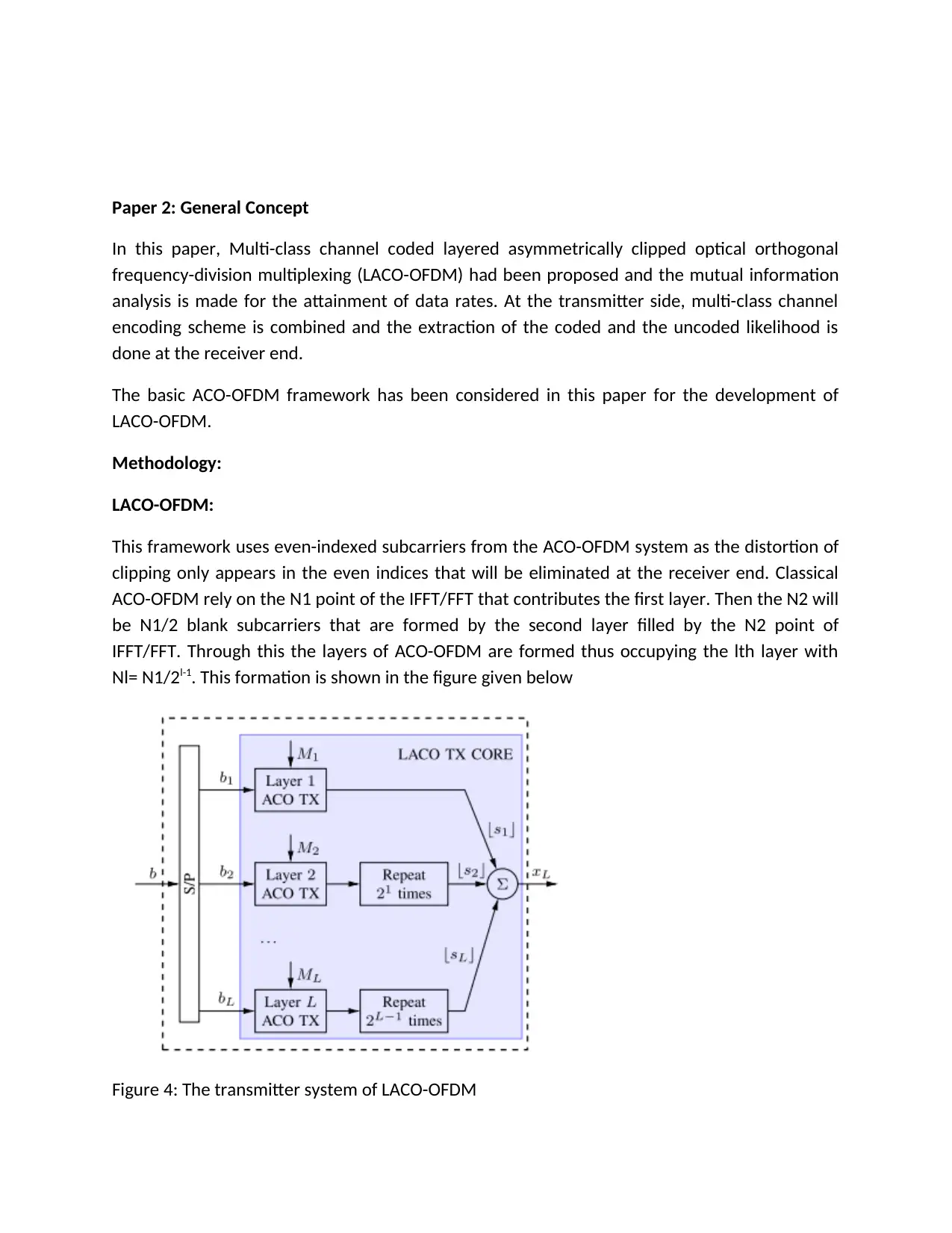
Paper 2: General Concept
In this paper, Multi-class channel coded layered asymmetrically clipped optical orthogonal
frequency-division multiplexing (LACO-OFDM) had been proposed and the mutual information
analysis is made for the attainment of data rates. At the transmitter side, multi-class channel
encoding scheme is combined and the extraction of the coded and the uncoded likelihood is
done at the receiver end.
The basic ACO-OFDM framework has been considered in this paper for the development of
LACO-OFDM.
Methodology:
LACO-OFDM:
This framework uses even-indexed subcarriers from the ACO-OFDM system as the distortion of
clipping only appears in the even indices that will be eliminated at the receiver end. Classical
ACO-OFDM rely on the N1 point of the IFFT/FFT that contributes the first layer. Then the N2 will
be N1/2 blank subcarriers that are formed by the second layer filled by the N2 point of
IFFT/FFT. Through this the layers of ACO-OFDM are formed thus occupying the lth layer with
Nl= N1/2l-1. This formation is shown in the figure given below
Figure 4: The transmitter system of LACO-OFDM
In this paper, Multi-class channel coded layered asymmetrically clipped optical orthogonal
frequency-division multiplexing (LACO-OFDM) had been proposed and the mutual information
analysis is made for the attainment of data rates. At the transmitter side, multi-class channel
encoding scheme is combined and the extraction of the coded and the uncoded likelihood is
done at the receiver end.
The basic ACO-OFDM framework has been considered in this paper for the development of
LACO-OFDM.
Methodology:
LACO-OFDM:
This framework uses even-indexed subcarriers from the ACO-OFDM system as the distortion of
clipping only appears in the even indices that will be eliminated at the receiver end. Classical
ACO-OFDM rely on the N1 point of the IFFT/FFT that contributes the first layer. Then the N2 will
be N1/2 blank subcarriers that are formed by the second layer filled by the N2 point of
IFFT/FFT. Through this the layers of ACO-OFDM are formed thus occupying the lth layer with
Nl= N1/2l-1. This formation is shown in the figure given below
Figure 4: The transmitter system of LACO-OFDM
⊘ This is a preview!⊘
Do you want full access?
Subscribe today to unlock all pages.

Trusted by 1+ million students worldwide
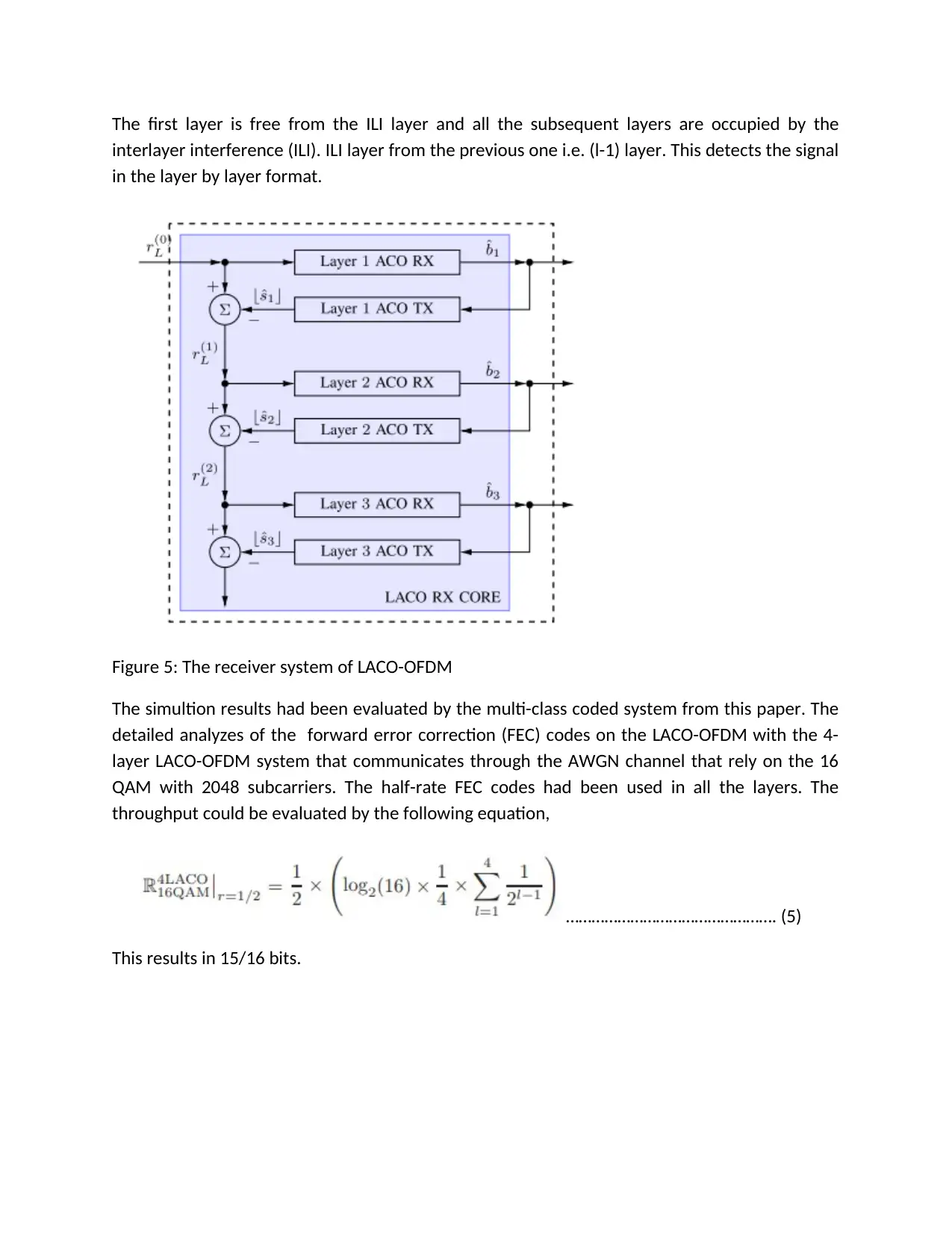
The first layer is free from the ILI layer and all the subsequent layers are occupied by the
interlayer interference (ILI). ILI layer from the previous one i.e. (l-1) layer. This detects the signal
in the layer by layer format.
Figure 5: The receiver system of LACO-OFDM
The simultion results had been evaluated by the multi-class coded system from this paper. The
detailed analyzes of the forward error correction (FEC) codes on the LACO-OFDM with the 4-
layer LACO-OFDM system that communicates through the AWGN channel that rely on the 16
QAM with 2048 subcarriers. The half-rate FEC codes had been used in all the layers. The
throughput could be evaluated by the following equation,
…………………………………………. (5)
This results in 15/16 bits.
interlayer interference (ILI). ILI layer from the previous one i.e. (l-1) layer. This detects the signal
in the layer by layer format.
Figure 5: The receiver system of LACO-OFDM
The simultion results had been evaluated by the multi-class coded system from this paper. The
detailed analyzes of the forward error correction (FEC) codes on the LACO-OFDM with the 4-
layer LACO-OFDM system that communicates through the AWGN channel that rely on the 16
QAM with 2048 subcarriers. The half-rate FEC codes had been used in all the layers. The
throughput could be evaluated by the following equation,
…………………………………………. (5)
This results in 15/16 bits.
Paraphrase This Document
Need a fresh take? Get an instant paraphrase of this document with our AI Paraphraser
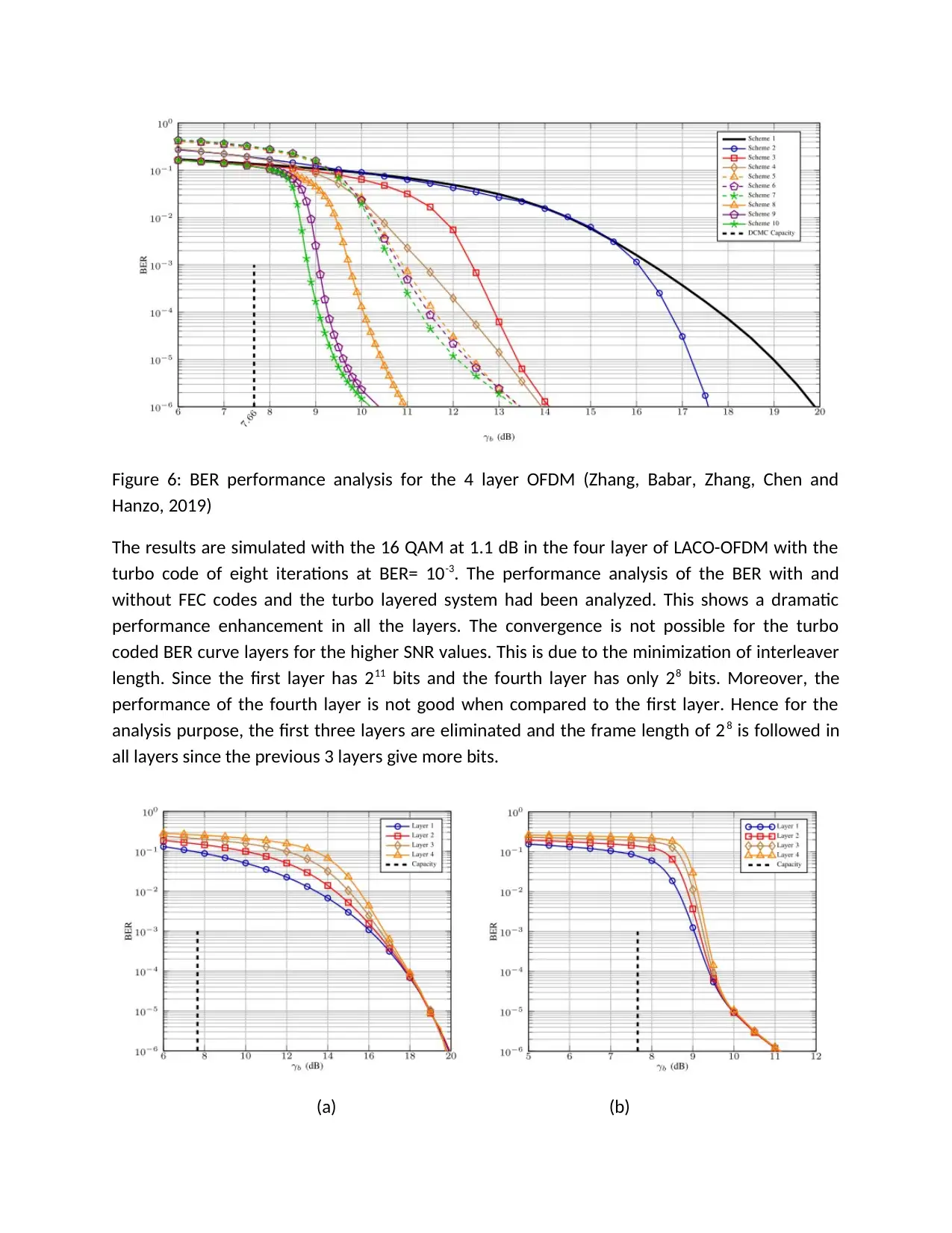
Figure 6: BER performance analysis for the 4 layer OFDM (Zhang, Babar, Zhang, Chen and
Hanzo, 2019)
The results are simulated with the 16 QAM at 1.1 dB in the four layer of LACO-OFDM with the
turbo code of eight iterations at BER= 10-3. The performance analysis of the BER with and
without FEC codes and the turbo layered system had been analyzed. This shows a dramatic
performance enhancement in all the layers. The convergence is not possible for the turbo
coded BER curve layers for the higher SNR values. This is due to the minimization of interleaver
length. Since the first layer has 211 bits and the fourth layer has only 28 bits. Moreover, the
performance of the fourth layer is not good when compared to the first layer. Hence for the
analysis purpose, the first three layers are eliminated and the frame length of 28 is followed in
all layers since the previous 3 layers give more bits.
(a) (b)
Hanzo, 2019)
The results are simulated with the 16 QAM at 1.1 dB in the four layer of LACO-OFDM with the
turbo code of eight iterations at BER= 10-3. The performance analysis of the BER with and
without FEC codes and the turbo layered system had been analyzed. This shows a dramatic
performance enhancement in all the layers. The convergence is not possible for the turbo
coded BER curve layers for the higher SNR values. This is due to the minimization of interleaver
length. Since the first layer has 211 bits and the fourth layer has only 28 bits. Moreover, the
performance of the fourth layer is not good when compared to the first layer. Hence for the
analysis purpose, the first three layers are eliminated and the frame length of 28 is followed in
all layers since the previous 3 layers give more bits.
(a) (b)
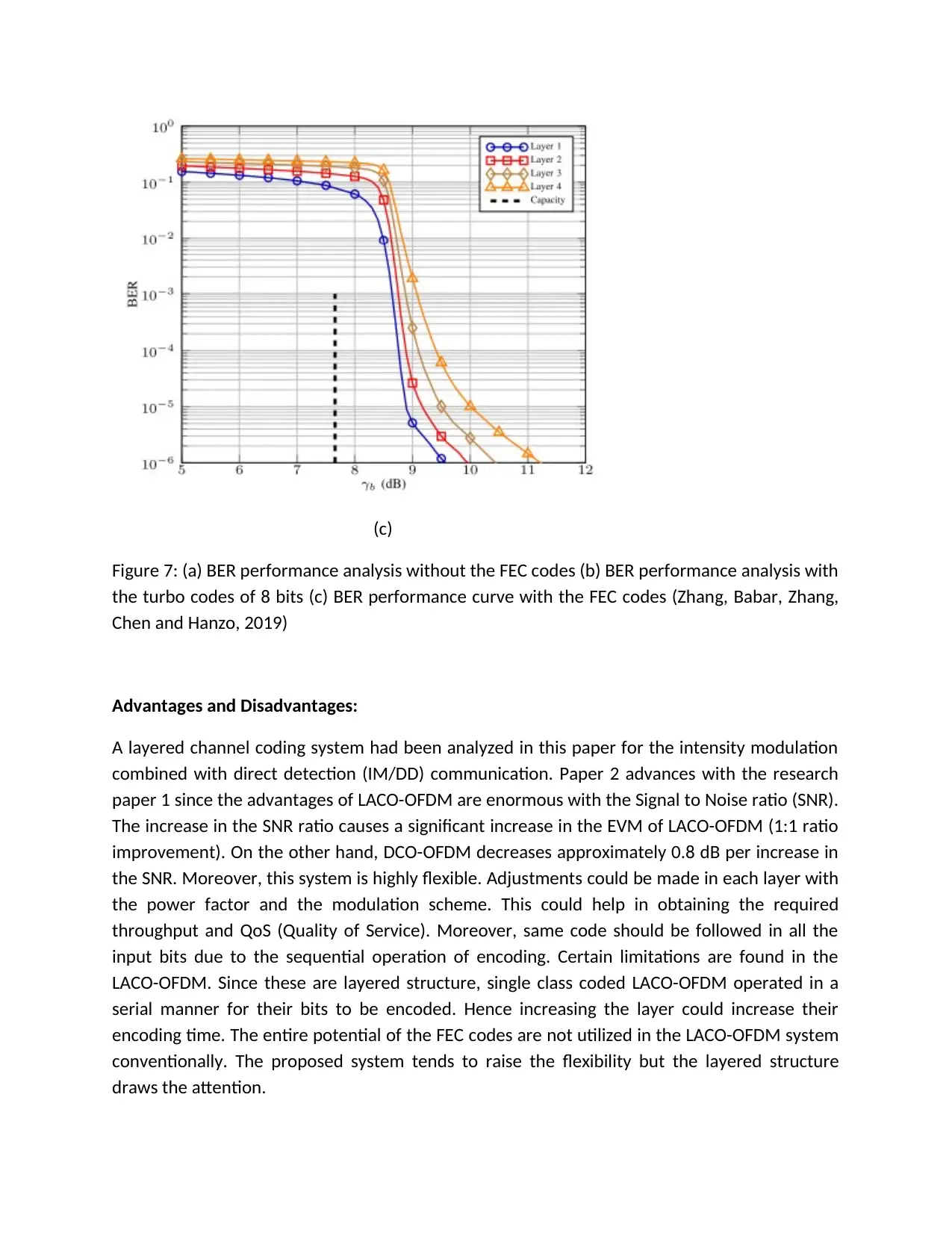
(c)
Figure 7: (a) BER performance analysis without the FEC codes (b) BER performance analysis with
the turbo codes of 8 bits (c) BER performance curve with the FEC codes (Zhang, Babar, Zhang,
Chen and Hanzo, 2019)
Advantages and Disadvantages:
A layered channel coding system had been analyzed in this paper for the intensity modulation
combined with direct detection (IM/DD) communication. Paper 2 advances with the research
paper 1 since the advantages of LACO-OFDM are enormous with the Signal to Noise ratio (SNR).
The increase in the SNR ratio causes a significant increase in the EVM of LACO-OFDM (1:1 ratio
improvement). On the other hand, DCO-OFDM decreases approximately 0.8 dB per increase in
the SNR. Moreover, this system is highly flexible. Adjustments could be made in each layer with
the power factor and the modulation scheme. This could help in obtaining the required
throughput and QoS (Quality of Service). Moreover, same code should be followed in all the
input bits due to the sequential operation of encoding. Certain limitations are found in the
LACO-OFDM. Since these are layered structure, single class coded LACO-OFDM operated in a
serial manner for their bits to be encoded. Hence increasing the layer could increase their
encoding time. The entire potential of the FEC codes are not utilized in the LACO-OFDM system
conventionally. The proposed system tends to raise the flexibility but the layered structure
draws the attention.
Figure 7: (a) BER performance analysis without the FEC codes (b) BER performance analysis with
the turbo codes of 8 bits (c) BER performance curve with the FEC codes (Zhang, Babar, Zhang,
Chen and Hanzo, 2019)
Advantages and Disadvantages:
A layered channel coding system had been analyzed in this paper for the intensity modulation
combined with direct detection (IM/DD) communication. Paper 2 advances with the research
paper 1 since the advantages of LACO-OFDM are enormous with the Signal to Noise ratio (SNR).
The increase in the SNR ratio causes a significant increase in the EVM of LACO-OFDM (1:1 ratio
improvement). On the other hand, DCO-OFDM decreases approximately 0.8 dB per increase in
the SNR. Moreover, this system is highly flexible. Adjustments could be made in each layer with
the power factor and the modulation scheme. This could help in obtaining the required
throughput and QoS (Quality of Service). Moreover, same code should be followed in all the
input bits due to the sequential operation of encoding. Certain limitations are found in the
LACO-OFDM. Since these are layered structure, single class coded LACO-OFDM operated in a
serial manner for their bits to be encoded. Hence increasing the layer could increase their
encoding time. The entire potential of the FEC codes are not utilized in the LACO-OFDM system
conventionally. The proposed system tends to raise the flexibility but the layered structure
draws the attention.
⊘ This is a preview!⊘
Do you want full access?
Subscribe today to unlock all pages.

Trusted by 1+ million students worldwide
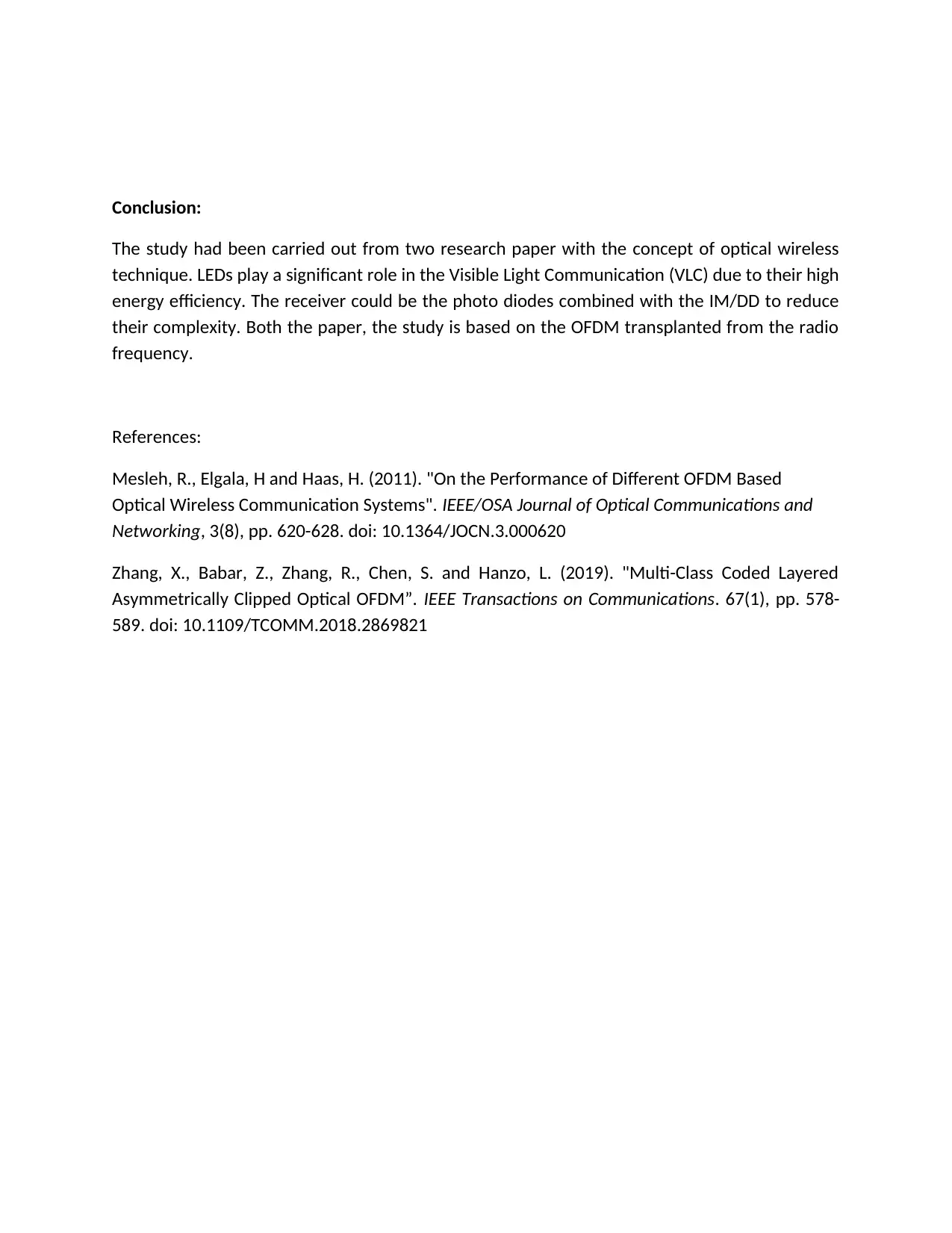
Conclusion:
The study had been carried out from two research paper with the concept of optical wireless
technique. LEDs play a significant role in the Visible Light Communication (VLC) due to their high
energy efficiency. The receiver could be the photo diodes combined with the IM/DD to reduce
their complexity. Both the paper, the study is based on the OFDM transplanted from the radio
frequency.
References:
Mesleh, R., Elgala, H and Haas, H. (2011). "On the Performance of Different OFDM Based
Optical Wireless Communication Systems". IEEE/OSA Journal of Optical Communications and
Networking, 3(8), pp. 620-628. doi: 10.1364/JOCN.3.000620
Zhang, X., Babar, Z., Zhang, R., Chen, S. and Hanzo, L. (2019). "Multi-Class Coded Layered
Asymmetrically Clipped Optical OFDM”. IEEE Transactions on Communications. 67(1), pp. 578-
589. doi: 10.1109/TCOMM.2018.2869821
The study had been carried out from two research paper with the concept of optical wireless
technique. LEDs play a significant role in the Visible Light Communication (VLC) due to their high
energy efficiency. The receiver could be the photo diodes combined with the IM/DD to reduce
their complexity. Both the paper, the study is based on the OFDM transplanted from the radio
frequency.
References:
Mesleh, R., Elgala, H and Haas, H. (2011). "On the Performance of Different OFDM Based
Optical Wireless Communication Systems". IEEE/OSA Journal of Optical Communications and
Networking, 3(8), pp. 620-628. doi: 10.1364/JOCN.3.000620
Zhang, X., Babar, Z., Zhang, R., Chen, S. and Hanzo, L. (2019). "Multi-Class Coded Layered
Asymmetrically Clipped Optical OFDM”. IEEE Transactions on Communications. 67(1), pp. 578-
589. doi: 10.1109/TCOMM.2018.2869821
1 out of 10
Your All-in-One AI-Powered Toolkit for Academic Success.
+13062052269
info@desklib.com
Available 24*7 on WhatsApp / Email
![[object Object]](/_next/static/media/star-bottom.7253800d.svg)
Unlock your academic potential
Copyright © 2020–2025 A2Z Services. All Rights Reserved. Developed and managed by ZUCOL.